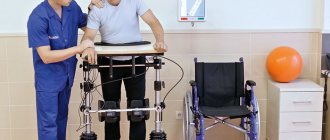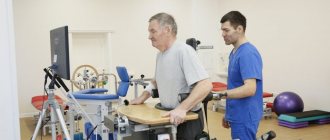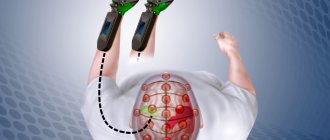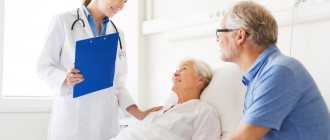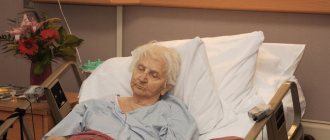Along with speech and cognitive impairments, patients who have suffered a stroke often develop various types of psycho-emotional disorders. The palm belongs to depression, anxiety, asthenia, apathy, lack of spontaneity, and negativism. Euphoria and complacency are recorded less frequently.
Post-stroke psycho-emotional disorders cause a decrease in the effectiveness of treatment and rehabilitation measures, delaying the prospect of returning to a natural social environment. The development of mental disorders has a depressing effect on patients and their caregivers and significantly reduces their quality of life.
The process of psychological rehabilitation is aimed at the patient’s possible full and early return to work and a full life, overcoming the psycho-emotional consequences of the disease. This is a consistent systemic activity aimed at restoring the patient’s personal and social status.
Psychoemotional disorders as consequences of stroke
A significant number of people experience psychological difficulties, psycho-emotional problems and depression after a stroke. Many sufferers need mental health restoration and relief from depression, anxiety, frustration or anger.
According to statistics, psycho-emotional disorders after a stroke occur in the majority of patients – in 30–65% of cases. The dominant positions are occupied by disorders of the depressive and anxiety spectrum (in 20–45% of patients). These concomitant neurotic and psychotic diseases have a strong negative impact on both the quality of life and the functional abilities of the body.
In a sample of more than 50,000 stroke patients, those patients diagnosed with depression or other mental health problems had a 3-fold increased risk of death within 10 years of the first episode, even after the effects of other negative chronic conditions was statistically controlled.
Features of aggression after a stroke
This behavior can develop immediately after an acute brain injury, but more often the signs of this problem appear gradually.
An attack of aggression after a stroke is preceded by:
- depression of the general mental state, low mood, apathy, indifference, “withdrawal” into oneself;
- sleep disorders, loss of appetite and body weight;
- suicidal thoughts;
- in a later period, pronounced mood swings develop, accompanied by emotional and mental flattening.
Against this background, the first outbreaks of anger begin to appear. It can be directed either at people or at oneself, or abstractly - at some ongoing events. Gradually the attacks become longer and more intense.
During a paroxysm of aggression after a stroke, the patient begins to scream, gesticulate vigorously, shower others with curses, and accuse others of non-existent actions. In the midst of it, the patient may assault him or throw objects that come into his hand. His breathing is noisy and rapid, his face is twisted with anger, and foam often appears on his lips. In this state, he can cause serious injury to himself and others. If the patient is limited in movement, he may fall out of bed or from a chair, hit his head on the floor, tear blankets and sheets with his hands.
This condition is very dangerous, so those around the patient should know the rules of behavior, which, in essence, are first aid during an attack.
Post-stroke depression
It has been established that approximately a third of all people who have suffered a stroke develop clinical depression. Women are at higher risk of developing depression than men. Depression after a stroke has both physical and psychological causes. People who had depressive episodes before the stroke are more likely to experience symptoms of the disease after the cerebral circulation has been disrupted. Depressive disorder is closely related to existing cognitive impairment after stroke, so these two problems must be considered and resolved together.
Gloom, sadness and sadness have a huge negative impact on the lives of people after stroke and those who care for them. People who are used to living independently suddenly become dependent on caregivers. A stroke results in significant physical, psychological and financial changes that a person must make in their daily life. Psychotherapy and other forms of psychological counseling can help restore a proper level of independence and gradually adjust to the changes caused by the stroke.
Several factors influence the risk of developing and severity of depressive disorder.
Among them:
- the area of the brain affected by the stroke;
- personal and family history of mood disorders or pathological anxiety;
- level of social isolation before stroke.
The disorder is diagnosed if the classic depressive triad of symptoms has been present for more than two weeks.
Typical signs and warning signs include:
- deep all-encompassing sadness;
- causeless anxiety;
- loss of interest in activities that were once enjoyable;
- lack of motivation to activity;
- difficulties in making decisions;
- poor concentration;
- difficulty remembering details;
- low self-esteem;
- feeling of uselessness, helplessness;
- problems with sleep quality, difficulty falling asleep;
- overeating or loss of appetite.
Some people who are depressed may be unable to properly modulate their emotions. They may laugh or cry for no reason and become emotionally unstable. Existing drug or alcohol problems may resurface or worsen, making rehabilitation efforts much more difficult.
Recovery from depression takes time and consistent medical work, but proper treatment ensures the patient’s full recovery. Currently, specialists from the community of rehabilitation specialists and psychologists Irakli Pozharisky use the most common and effective methods of psychotherapeutic treatment of depression.
People recover faster after a stroke if they receive good support and comprehensive care. Patients recover more quickly when their care is well managed and a well-coordinated team of caregivers identifies and meets needs as they arise. The rehabilitation period after a stroke also requires that the individual be highly motivated to adhere to the care plan. Early identification of depression ensures that patients receive the support and understanding needed to adapt to sudden changes in their lives.
Treatment of aggression after stroke at the Verimed clinic
To stop such manifestations and stabilize the patient’s mental state, specialists try to use a whole range of measures.
Treatment for aggression during stroke includes:
- Prescription of tranquilizers. A specific drug is selected for each patient. His choice is based on the specific manifestations of the pathology and the doctor’s experience. For a faster development of the effect, the medicine is administered as an injection intramuscularly or intravenously;
- Use of antipsychotics. It is justified in more difficult situations. Such drugs have a more powerful effect due to the addition of an antipsychotic effect to the tranquilizing (sedative) effect.
- Prescribing antidepressants if the patient’s complaints reveal elements of a depressed state. The selection of these medications is associated with certain difficulties. It is not always possible to achieve the desired result immediately. The choice of an antidepressant is complicated by the fact that the effect of their use is noticeable only after a month of use.
- Acupuncture, which has a very mild therapeutic property. They resort to it during the interictal period.
- Massage and physical therapy (both passive and active), the health-improving and preventive results of which are very great.
- Methods of psychotherapy. Working with patients as psychologists and psychotherapists allows them to eliminate the main causal components of aggression after a stroke, help them correctly understand their situation, find and set goals for their future life.
Patients are recommended to undergo sanatorium-resort treatment. A favorable climate, a change of environment, and rehabilitation measures can significantly mitigate or even completely eliminate the signs of aggressive reactions.
Treatment of aggression in women differs in duration and the need to use special enhanced versions of psychotherapeutic methods. The conditions of the Verimed clinic, the qualifications and personal characteristics of the doctors allow us to help all patients who apply. Have you encountered this problem? Don't wait for tomorrow - just call us now!
Post-stroke anxiety conditions
Post-stroke anxiety is determined with a frequency of 5 to 15%. At the same time, in countries with insufficient quality of medical care, a constant feeling of anxiety is present in 25% of patients, while in 20% of stroke survivors, a generalized anxiety disorder develops and progresses. In most cases, post-stroke anxiety is a companion to clinical depression. Although an abnormal level of anxiety in itself does not lead to a deterioration in cognitive potential, constant insurmountable anxiety does not allow the patient to adapt normally to functioning in society and significantly worsens the quality of life.
All-consuming anxiety negatively affects a person’s character and his style of interaction with society. A patient with an anxiety disorder becomes nervous and irritable, losing his temper for no reason. Due to constant nervous tension, he conflicts and gets into arguments with others. It is difficult for him to organize his day and bring the work he has begun to its logical conclusion. The slightest obstacles and everyday difficulties lead him into a state of panic.
Since the patient's thinking is overwhelmed by anxious thoughts, he cannot concentrate on the task at hand. Because of this, the quality of performance of his professional duties suffers. A decrease in the ability to concentrate and maintain attention is also due to “chewing mental cud.”
Irrational anxiety negatively affects sleep patterns and quality. Common problems of a patient with an anxiety disorder are persistent insomnia, nightmares, and frequent waking up in the middle of the night. Such phenomena lead to the fact that in the morning a person feels overwhelmed and exhausted.
It should be remembered that no pharmacological products can completely eliminate pathological anxiety, since they only work to relieve the symptoms of the disorder. You can only get rid of abnormal anxiety through psychotherapy. The main task of the psychotherapist is to convey to the client true information about what causes his anxious state, teach him ways to manage his thinking and behavior, and motivate him to replace dysfunctional thoughts with constructive ideas.
Medical certificate
Stroke is neurological in nature. The cause of this terrible disease is an acute violation of cerebral circulation. It is disrupted due to blockage of blood vessels by blood clots or due to embolism of the cerebral arteries. Stroke is most common among residents of developed countries. A sedentary lifestyle is thought to increase the risk of stroke. The brain is poorly supplied with oxygen, which leads to acute brain hypoxia and subsequent death of nerve cells.
Nervous tissue is the most delicate and sensitive. She absolutely cannot tolerate circulatory disturbances: this leads to the rapid onset of ischemia and disruption of the normal functioning of neurons. Just half an hour after the blood flow is disrupted, irreversible changes occur, which forms the picture of the disease. Thus, in case of a stroke, it is important to help the person as soon as possible, before the changes become irreversible.
In medicine, it is customary to divide stroke into two categories:
- ischemic, when there is complete occlusion of the lumen of the vessels;
- hemorrhagic, when the vessel ruptures and hemorrhage occurs into the surrounding tissue. In this case, a cerebral hematoma is observed.
The mechanisms of disease development are approximately the same, but the consequences may be different. Statistics say that in 80% of cases it is the ischemic form of stroke. Both forms of stroke are associated with atherosclerotic changes in the vascular system. Important: hemorrhagic stroke is more dangerous, since when a hematoma develops, a shift in the brain can sometimes occur.
Post-stroke aggression and rage
In the acute and subacute phase of stroke, patients often experience causeless, uncontrollable aggression, outwardly expressed by an angry attitude towards others and the commission of violent acts. This phenomenon is described by doctors as post-stroke rage. The prevalence of this problem reaches 35% of cases in the acute stage of stroke. As the crisis subsides, the level of aggression and rage decreases.
The mechanism of development of post-stroke rage has been well studied. It has been established that such a psychoemotional disorder is often associated with damage to the ventral prefrontal cortex of the brain.
A stroke survivor may exhibit different types of aggressive reactions. The most common forms are:
- physical aggression, which involves using physical force to attack another person;
- indirect aggression, which means humiliation of another person through slander, gossip, and malicious statements;
- explosions of rage that do not have a specific addressee (stomping feet, banging fists on the table, breaking dishes, slamming doors);
- verbal aggression - demonstration of one’s feelings through screams, threats, curses;
- passive or active negativism – actions aimed at undermining the authority of medical personnel.
Any manifestations of aggressive behavior require immediate consultation with a psychotherapist and corrective work.
Some advice to others
If you witness an episode of inappropriate behavior, try to follow these recommendations:
- Be calm.
- Remove from the apartment (house) all sounds that irritate the patient (music, TV), excessive lighting and dangerous objects.
- Talk to the patient calmly, kindly, and say soothing phrases. Don’t swear, don’t raise your voice at him;
- Do not leave the patient alone.
- In case of a severe attack, immediately call a specialized assistance team, and be sure to consult with a specialist, even if the aggressive behavior was short-lived.
Anosognosia
Another consequence of a stroke is anosognosia, characterized by a lack of critical assessment of health status and denial of an existing defect. The patient can claim that he does not have paralysis, his vision, hearing and speech are normal, and his mental sphere is absolutely healthy. For example, a paralyzed patient can tell the doctor how he moved, lifted, and controlled his injured arm.
In most cases, anosognosia is a consequence of damage to the right parietal lobe of the brain. This phenomenon is considered in psychology as “denial,” that is, a person’s desire to avoid accepting truthful information about himself that is incompatible with existing ideas about his own body and spiritual world.
Denial is a deterrent that allows you to unconsciously reduce disturbing experiences. The development scheme of anosognosia can be presented as follows: distorted perception of real factors - the need to eliminate psycho-emotional stress - the inclusion of psychological defense mechanisms. This protective behavior helps the patient feel included in social activities.
However, anosognosia acts as a significant obstacle to treatment, becoming a kind of “counterweight”. The psychologist has to make considerable efforts to rid the patient of illusions and return him to reality.
Causes of psychosis in old age
- Predisposition (psychosis in old age in blood relatives is a risk factor).
- Long-term and untreated cerebral atherosclerosis, hypertension, hypotension, diabetes mellitus.
- Abuse of sleeping pills, alcohol-containing drops, alcohol and other psychoactive substances. Alcoholism.
- Previous strokes and heart attacks.
- Traumatic brain injuries.
- Changing your usual lifestyle (moving to a new place, disrupting your sleep patterns).
- Neoplasms in brain tissue.
- Exacerbation of a chronic somatic illness or acute inflammation (for example, pneumonia).
Therapeutic approaches in the treatment of psychoemotional disorders
The following therapeutic approaches have proven themselves well in the treatment of psychoemotional disorders initiated by acute cerebrovascular accident.
Brief Solution Focused Therapy (BSFT)
The fundamental difference between this direction and other psychotherapeutic methods is not only the short duration of treatment (1-3 sessions), but also the focus on solving the problem. The psychotherapist's efforts are always aimed at the main goal that the client has set for himself. The specialist’s task is not to focus on problems, but to actualize and stimulate a person’s existing potential, to identify and develop existing abilities.
Problem-Solving Therapy (PST)
This short-term method (4-8 sessions) aims to reduce the severity of depression and anxiety disorders by recognizing the relationship between the symptoms demonstrated and existing problems in the person's life. Problems are identified during an unobtrusive conversation. The psychotherapist’s task is to teach the client to develop a systematic, structured approach to overcome life’s obstacles.
Cognitive Behavioral Therapy (CBT)
Cognitive behavioral therapy focuses on exploring the relationships between an individual's thoughts, experiences, and behavior. By exploring destructive thought patterns that contribute to self-destructive actions and stereotypical beliefs that drive a person's behavior, the therapist motivates the client to replace them with functional ideas.
Acceptance and Commitment Therapy (ACT)
This method teaches stroke survivors to simply “notice,” accept, and take personal responsibility for thoughts, experiences, sensations, memories, and events that occur. Instead of trying to take undesirable phenomena under control, the psychologist invites the client to give up the meaningless struggle with reality and recognize the right to be as he is.
Interpersonal Psychotherapy (IPT)
The direction is based on the working principle of “here and now” and focuses on interpersonal relationships. A therapist helps improve the way a depressed person communicates. The technique allows the client to identify their emotions and their sources, express feelings in a healthy way and eliminate negative emotional baggage from the past.
Mindfulness-based Cognitive Therapy (MCT)
Mindfulness-based cognitive therapy helps those who suffer from recurrent bouts of depression and chronic unhappiness. The method combined the ideas of cognitive therapy with meditative practices and attitudes based on the cultivation of mindfulness. The main idea of the method is based on the assumption that depressive mood and negative catastrophizing self-devaluing thinking form an associative connection.
Causes of stroke
Stroke is a so-called multifactorial disease. It is believed that stroke has many different causes, each of which makes a specific contribution:
- unhealthy lifestyle, which may include overeating and physical inactivity;
- great psycho-emotional stress;
- bad habits, especially smoking;
- hypertonic disease;
- some other factors, including heredity.
These factors can act together or separately.
What are the causes of aggressive behavior in people who have had a stroke? They are:
- damage to areas of the cerebral cortex responsible for emotions, behavior and intelligence;
- extensive brain damage. This is the most common cause of aggression.
One of the common consequences of a stroke is paresis of the facial muscles. The man's face contorts. Important: aggression in people who have suffered a stroke may develop not as a result of damage to areas of the brain, but already during the rehabilitation period, when a person cannot come to terms with the loss of certain functions of his body.



